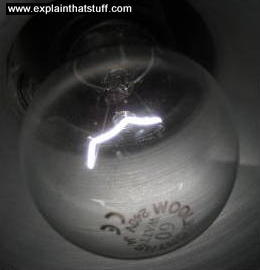

Tungsten
by
By the light, of the silvery moon... We'll be cuddlin' soon, By
the silvery moon. So run the lyrics to a popular song published in 1909.
Back then,
Until
Photo: The glowing white line is the filament of an old-style incandescent lamp.
Really, it's just a very tight coil of thin wire. When electricity passes through the filament, its
high
What is tungsten?
Tungsten is a silvery-white, hard and strong metal that lives in
group 6 (VIb) of the Periodic Table. Like
Where does tungsten come from?

Photo: Mineral rich: A space
Tungsten is moderately common in Earth's crust: it's the 57th most common chemical element out of the 92 that are found in nature—so roughly in the middle of the list. In practice, you'd need to dig up up about 1.5 tonnes of rock to get about 1 gram (0.04 ounces) of tungsten, so you can see mining the stuff is pretty hard work! What makes it harder is that tungsten doesn't occur naturally in its pure state but only combined with other metals, mostly in two minerals called scheelite (a compound of calcium, tungsten, and oxygen with the chemical formula CaWO4) and wolframite (an intermediate compound that includes either iron or manganese plus tungsten and oxygen).
Traditionally, tungsten is extracted from its minerals by a multi-stage process:
- The minerals are reacted with sodium carbonate or sodium hydroxide to produce sodium tungstate.
- The sodium tungstate is washed with water and reacted with hydrochloric acid to make tungstic acid (H2WO4).
- The tungstic acid is washed and dried to produce tungsten trioxide (WO3). A metric tonne of tungsten trioxide contains about 8kg of tungsten.
- The tungsten trioxide is heated in a furnace with hydrogen. The hydrogen reduces the oxide (removes its oxygen atoms) leaving pure tungsten metal, which can then be worked and shaped (pressed, hammered, or pulled) into bars, wires, or whatever form is needed.

Chart: Where does the United States get its tungsten from? Since 2010, there's been a marked reduction in the dependency on imports from China. Inner ring (white labels): 2010–2013; Middle ring (green labels): 2012–2015 Middle ring (black labels): 2013–2016; Outer ring (yellow labels): 2014–2017. Source: U.S. Geological Survey, Mineral Commodity Summaries: Tungsten, 2016–2019.
Much of the world's tungsten is currently bought and sold in the form of a convenient, white powder called ammonium paratungstate, a complex chemical salt of ammonium and tungsten with the formula (NH4)10(H2W12O42)·4H2O. It's easy to transport and easy to convert into all kinds of tungsten-based materials. In 2017, 10kg (confusingly, also known as 1 metric ton unit or 1MTU) of APT powder cost around $250 in the United States; in 2018, the price has continued to climb to around $300–400.
Most of the world's tungsten comes from China, though other countries have become increasingly significant suppliers since 2010. Other important producers of tungsten ore include Vietnam (which became the world's second biggest producer in 2014), Russia, the United States, and Bolivia. Canada, once a leading producer, suspended operations in 2015. Between 2010 and 2013, the United States imported roughly 43 percent of its tungsten from China, 8 percent from Bolivia, 6 percent from Canada, 5 percent from Germany, and 38 percent from the rest of the world; between 2014 and 2017, the breakdown of imports shifted to 32 percent from China, 8 percent from Canada, 9 percent from Bolivia, 9 percent from Germany, and 42 percent from the rest of the world.


Chart: World of tungsten: Which countries have and produce the most tungsten? 1) World tungsten reserves: China has over half of all world resources and reserves and some of the largest deposits (concentrated in single areas). 2) World mine production: China produces over 80 percent of the world's tungsten. Source: U.S. Geological Survey, Mineral Commodity Summaries: Tungsten, January 2016–2019.
What is tungsten like?
Physical properties
Pure tungsten metal is grayish or silvery-white, extremely hard
(roughly similar to hardened

Photo: Tungsten carbide is widely used in cutting and drilling tools. About 60 percent of the tungsten consumed in the United States finds its way into carbide tools.
Chemical properties
Tungsten is reasonably unreactive (inert). It doesn't dissolve in
What is tungsten used for?

Photo: Hot stuff! You need incredibly high temperatures to melt metals and
Its physical and chemical properties make tungsten useful in two
particular areas: 1) very hard tools and 2) components and materials that can survive high temperatures.
Tungsten carbide is widely used as a coating for cutting tools such as saws,
There are many other, less well-known uses for tungsten
include the manufacture of
